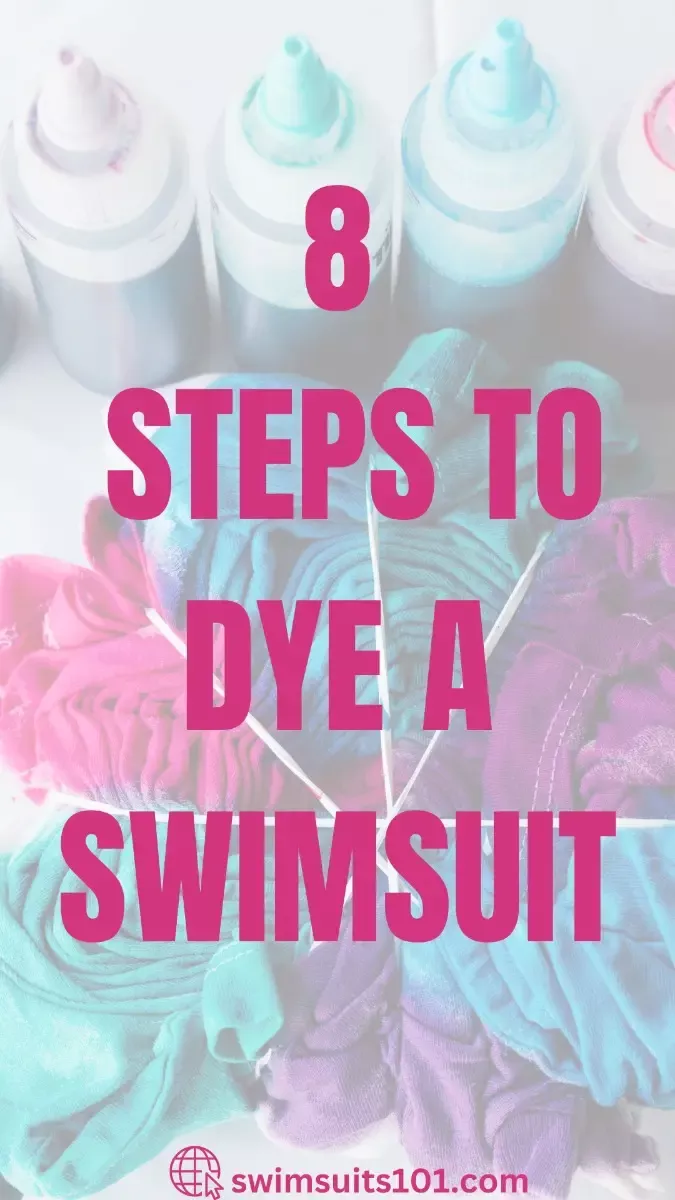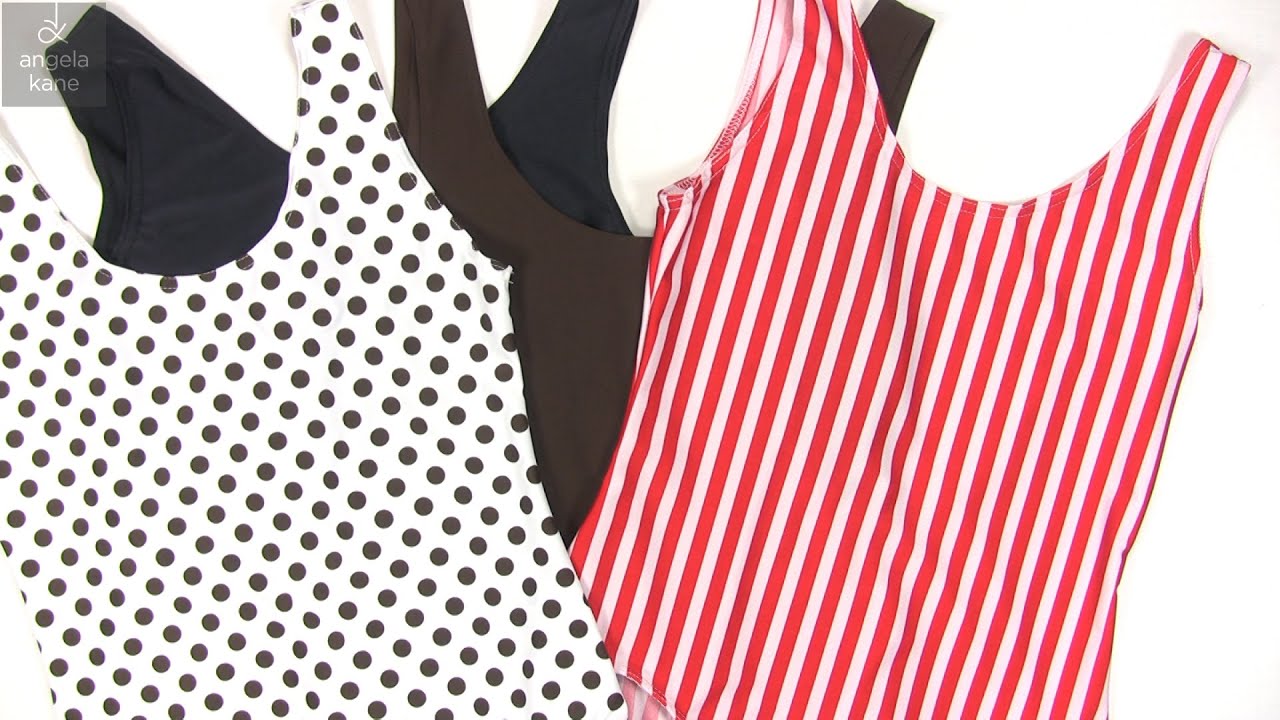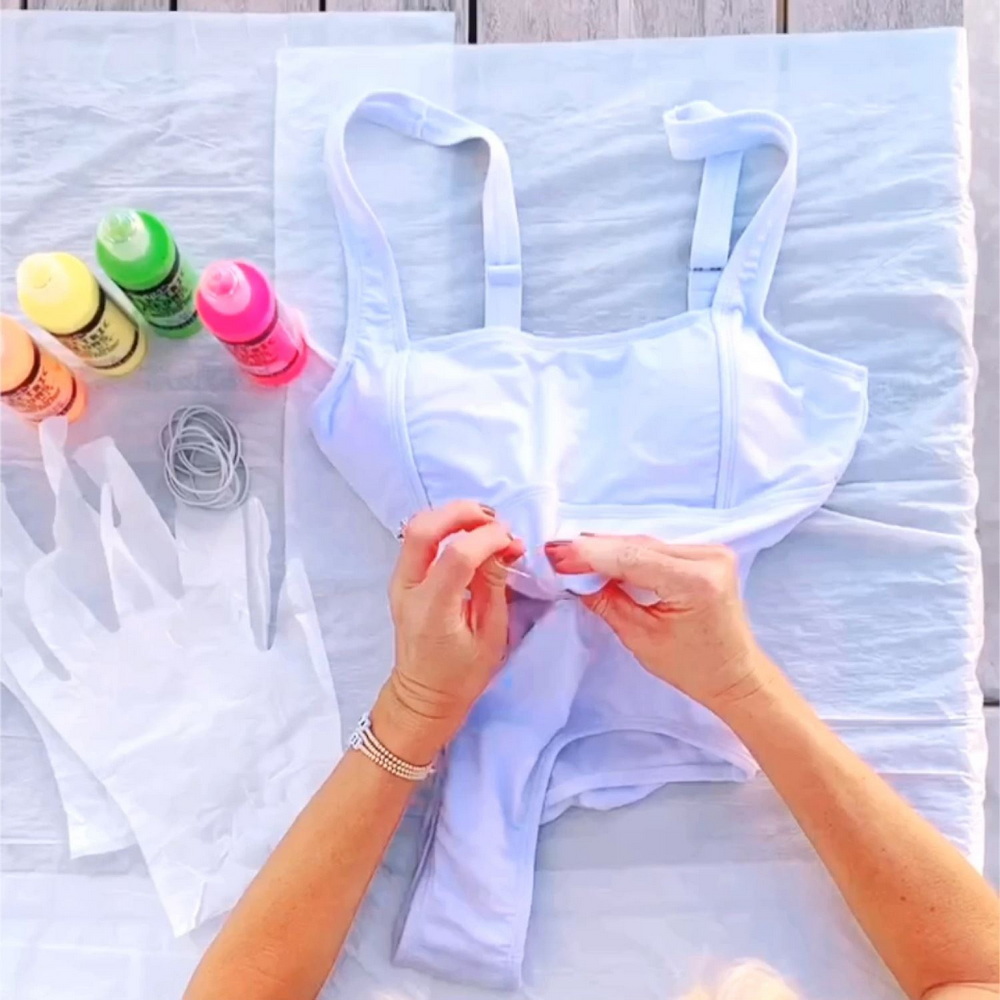Content Menu
● Introduction to Dyeing Lycra Swimwear
>> Understanding Lycra and Its Properties
>> Choosing the Right Dye
>> Preparing Your Workspace and Materials
>> Pre-Dyeing Steps
>> The Dyeing Process
>> Creative Dyeing Techniques
>> Tips for Success
● Common Mistakes and Troubleshooting
>> Avoiding Common Mistakes
>> Troubleshooting
● Caring for Your Dyed Lycra Swimwear
● Environmental Considerations
● Conclusion
● Frequently Asked Questions (FAQs)
>> Can all Lycra swimwear be dyed?
>> How long does the dye last?
>> Is the dye safe for my skin?
Discover the secret tips and tricks for achieving vibrant and long-lasting colors when dyeing your lycra swimwear at home.
Swimwear is an essential part of our summer wardrobe, and Lycra has become one of the most popular materials for creating comfortable and stylish swimsuits. But what if you have a Lycra swimsuit that you love, but you're not quite satisfied with its color? Or perhaps you've found a great deal on a plain white Lycra swimsuit and want to give it a personal touch? The good news is that you can indeed dye Lycra swimwear, and this article will guide you through the process, providing tips, techniques, and creative ideas to help you transform your swimsuit into a unique piece that reflects your personal style.
Introduction to Dyeing Lycra Swimwear
Dyeing Lycra swimwear can be a fun way to change the look of your favorite swimsuit. Have you ever wanted to make your old swimwear brighten up or match a special beach towel? If so, you might be wondering, "can you dye lycra swimwear?" The answer is yes, but it's not as simple as just throwing it in a dye bath.
Lycra is a special stretchy fabric often used in swimwear because it fits snugly and allows for easy movement. However, it has some unique challenges when it comes to color. In fact, many types of Lycra swimwear dye easily, while some do not. Understanding how to work with this fabric is key to getting the results you want. In this section, we will explore why someone might want to change their swimwear color and what makes dyeing Lycra a bit tricky.
Whether you want to refresh an old swimsuit or create a totally new look, knowing the basics of dyeing can help make the process easier and more successful. With tips and the right materials, you can turn your plain swimwear into something exciting and colorful!

Understanding Lycra and Its Properties
Before we dive into the dyeing process, it's essential to understand what Lycra is and why it's so popular in swimwear. Lycra, also known as spandex or elastane, is a synthetic fiber known for its exceptional elasticity. It's often blended with other materials like nylon or polyester to create swimwear fabric that is both stretchy and durable. This combination of properties makes Lycra swimwear comfortable, form-fitting, and resistant to the harsh effects of chlorine and saltwater.

The synthetic nature of Lycra presents both challenges and opportunities when it comes to dyeing. Unlike natural fibers like cotton or wool, which readily absorb dyes, synthetic fibers require special techniques and dyes to achieve vibrant, long-lasting colors. However, with the right approach, you can successfully dye your Lycra swimwear and achieve stunning results.
Choosing the Right Dye
The first and most crucial step in dyeing your Lycra swimwear is selecting the appropriate dye. Not all fabric dyes are suitable for synthetic materials like Lycra. You'll need to use a dye specifically formulated for synthetic fibers. These dyes, often referred to as disperse dyes or acid dyes, are designed to bond with synthetic materials at a molecular level, ensuring that the color penetrates the fabric and remains vibrant even after multiple washes and exposure to sun and water.
Some popular brands that offer dyes suitable for Lycra include Rit DyeMore, iDye Poly, and Jacquard iDye. These dyes come in a wide range of colors, allowing you to choose the perfect shade for your swimsuit. It's important to note that the final color may vary slightly depending on the original color of your swimsuit and the exact blend of materials it contains.
Preparing Your Workspace and Materials
Dyeing Lycra swimwear can be a messy process, so it's essential to prepare your workspace properly. Here's what you'll need:
1. A large stainless steel or enamel pot (do not use aluminum, as it can react with the dye)
2. A stove or hot plate
3. A long-handled spoon or tongs for stirring
4. Rubber gloves to protect your hands
5. Old towels or newspapers to protect your work surface
6. A thermometer to monitor water temperature
7. White vinegar (for some dyeing methods)
8. Mild detergent for pre-washing and post-dyeing care
Set up your workspace in a well-ventilated area, preferably outdoors or in a garage, to avoid any potential staining or fumes in your living space. Cover your work surface with old towels or newspapers to catch any spills.
Pre-Dyeing Steps
Before you begin the dyeing process, there are a few important steps to take:
1. Clean your swimsuit thoroughly: Wash your Lycra swimsuit with a mild detergent to remove any dirt, oils, or residues that could interfere with the dyeing process. Rinse well and gently squeeze out excess water.
2. Test a small, inconspicuous area: If possible, test the dye on a small, hidden part of the swimsuit to ensure that it takes the color well and that you're happy with the result.
3. Prepare your dye bath: Follow the instructions on your chosen dye product to prepare the dye bath. This usually involves mixing the dye with hot water and adding any necessary additives, such as salt or vinegar, depending on the type of dye you're using.
The Dyeing Process
Now that you've prepared everything, it's time to dye your Lycra swimsuit. Here's a step-by-step guide:
1. Heat the dye bath: Bring your prepared dye bath to the temperature recommended by the dye manufacturer. This is typically just below boiling point, around 200°F (93°C).
2. Add the swimsuit: Gently submerge your pre-wetted swimsuit into the dye bath. Use your long-handled spoon or tongs to ensure that the fabric is evenly distributed and not bunched up.
3. Maintain temperature and stir: Keep the dye bath at a constant temperature and stir gently but continuously. This helps ensure even dye distribution and prevents the swimsuit from developing streaks or blotches.
4. Monitor dyeing time: The length of time you leave your swimsuit in the dye bath will affect the intensity of the color. Start with the minimum time recommended by the dye manufacturer and check the color periodically. Remember that the color will appear darker when wet, so it's a good idea to lift a small section out of the water to get a better idea of the true color.
5. Rinse and wash: Once you're satisfied with the color, remove the swimsuit from the dye bath and rinse it thoroughly in cool water until the water runs clear. Then, wash the swimsuit in cool water with a mild detergent to remove any excess dye.
6. Dry and set the color: Gently squeeze out excess water and lay your swimsuit flat to dry. Avoid hanging it, as this can stretch the fabric. Once dry, you may want to iron the swimsuit on a low setting (if the care label allows) to help set the color.

Creative Dyeing Techniques
While solid colors are classic and versatile, you might want to experiment with more creative dyeing techniques to make your Lycra swimwear truly unique. Here are some ideas to inspire you:
1. Ombre effect: Create a gradient effect by gradually dipping your swimsuit into the dye bath. Start with the area you want darkest and slowly lower the rest of the swimsuit into the dye over time.
2. Tie-dye: Achieve fun, psychedelic patterns by tying your swimsuit with rubber bands before dyeing. The tied areas will resist the dye, creating interesting designs.
3. Dip-dye: Dye only a portion of your swimsuit for a bold, two-tone look. This works particularly well for one-piece swimsuits or tankinis.
4. Shibori techniques: Experiment with Japanese Shibori folding and binding techniques to create intricate patterns.
5. Color blocking: Use fabric paint or a different colored dye to create geometric shapes or patterns on your swimsuit.
Tips for Success
To ensure the best results when dyeing your Lycra swimwear, keep these tips in mind:
1. Always follow the manufacturer's instructions for both the dye and your swimsuit.
2. Remember that lighter colors are easier to dye than darker ones. If you're starting with a dark-colored swimsuit, you may need to use a color remover before dyeing.
3. Be patient and take your time. Rushing the process can lead to uneven coloring or damage to the fabric.
4. If you're not satisfied with the color after the first dyeing attempt, you can usually re-dye the swimsuit. Just be aware that multiple dyeing sessions may affect the fabric's elasticity.
5. Consider dyeing matching accessories like swim caps or cover-ups for a coordinated look.

Common Mistakes and Troubleshooting
Dyeing Lycra swimwear can be fun, but it also comes with its challenges. Many people make mistakes that can lead to disappointing results. Understanding these common mistakes can help you avoid them and achieve the color you want. Here are some important dyeing swimwear tips you can follow.
Avoiding Common Mistakes
One big mistake is not reading the instructions on the dye package. Each dye can have different mixing and application steps, so be sure to follow them carefully.
Another mistake is not preparing the swimwear properly. Always wash your Lycra swimsuit first to remove any chemicals or oils that might keep the dye from sticking. If you skip this step, the dye may not absorb evenly.
Using the wrong type of dye is also a common error. Remember that not all dyes are made for Lycra. Make sure to choose the best dye for Lycra to ensure a successful dyeing process.
Troubleshooting
Sometimes, even when you follow all the steps, you might face issues like uneven dye or fading colors. If your dye turns out uneven, it could be because you didn't stir the dye bath enough. Make sure to mix well so that every part of the swimsuit gets the same amount of dye.
If your colors start to fade after washing, you might not have fixed the dye properly. Using a color fixative can help keep the dye in place. Always rinse your swimwear in cold water after dyeing to help set the color.
Another concern is maintaining the elasticity of your Lycra swimwear. Dyeing can sometimes affect how stretchy the fabric is. To keep your swimwear stretchy, avoid using hot water during the dyeing process and follow the recommended temperatures on the dye package.
Caring for Your Dyed Lycra Swimwear
After you've successfully dyed your Lycra swimwear, proper care is essential to maintain its new color and extend its lifespan. Here are some care tips:
1. Rinse your swimsuit in cool, fresh water immediately after use, especially if you've been in chlorinated or salt water.
2. Hand wash your swimsuit using a mild detergent specifically designed for delicates or swimwear.
3. Avoid wringing or twisting the fabric, as this can damage the fibers and affect the fit.
4. Lay your swimsuit flat to dry in a shaded area, away from direct sunlight which can fade the color.
5. Rotate between multiple swimsuits if possible to allow each one time to fully dry and recover its shape between wears.

Environmental Considerations
As we become more aware of our impact on the environment, it's important to consider the ecological aspects of dyeing Lycra swimwear. Here are some eco-friendly tips:
1. Choose non-toxic, low-impact dyes when possible.
2. Dispose of dye waste properly, following local regulations.
3. Consider upcycling old swimsuits rather than buying new ones.
4. Look for swimwear made from recycled Lycra or other eco-friendly materials.
Conclusion
Dyeing Lycra swimwear is not only possible but can be a fun and rewarding DIY project. With the right materials, techniques, and a bit of patience, you can transform a plain or outdated swimsuit into a vibrant, personalized piece that reflects your style. Whether you're looking to refresh a favorite suit, create a custom color that's not available in stores, or experiment with unique patterns and designs, dyeing your Lycra swimwear opens up a world of creative possibilities.
Remember that practice makes perfect, so don't be discouraged if your first attempt doesn't turn out exactly as planned. Each dyeing project is an opportunity to learn and improve your skills. And who knows? You might discover a new hobby or even a small business opportunity in customizing swimwear for others.
So, the next time you're looking at your swimwear collection and wishing for something new, consider reaching for the dye instead of your wallet. With a little creativity and effort, you can breathe new life into your Lycra swimwear and hit the beach or pool in a truly one-of-a-kind suit that's sure to turn heads.

Whether you're dyeing a simple one-piece, a sporty bikini, or even accessories like swim caps and cover-ups, the process of transforming Lycra swimwear through dyeing is an exciting journey of color and creativity. So gather your materials, prepare your workspace, and dive into the world of swimwear dyeing. The perfect, personalized beach look is just a dye job away!
Frequently Asked Questions (FAQs)
Can all Lycra swimwear be dyed?
Not all Lycra swimwear can be dyed easily. Some swimsuits are made from a blend of materials, and if they have too much polyester or nylon, the dye may not stick well. You should check the label to see if the swimsuit is 100% Lycra. If it is, then you have a better chance of successfully dyeing it.
How long does the dye last?
The longevity of the dye on Lycra swimwear depends on how you take care of it after dyeing. If you wash it gently in cool water and avoid harsh chemicals, the color can last for a long time. However, all dyes fade a little over time, especially if the swimsuit is exposed to sunlight and chlorine. So, treating your newly dyed swimwear with care is key to keeping those colors bright!
Is the dye safe for my skin?
Most dyes for Lycra are designed to be safe, but it's always a good idea to check the label. Look for dyes that are specifically made for fabrics and are non-toxic. Before you wear your dyed swimsuit, you can do a patch test by applying a small amount of the dyed fabric to your skin for a few minutes. If there's no irritation, it's likely safe to wear!





































































